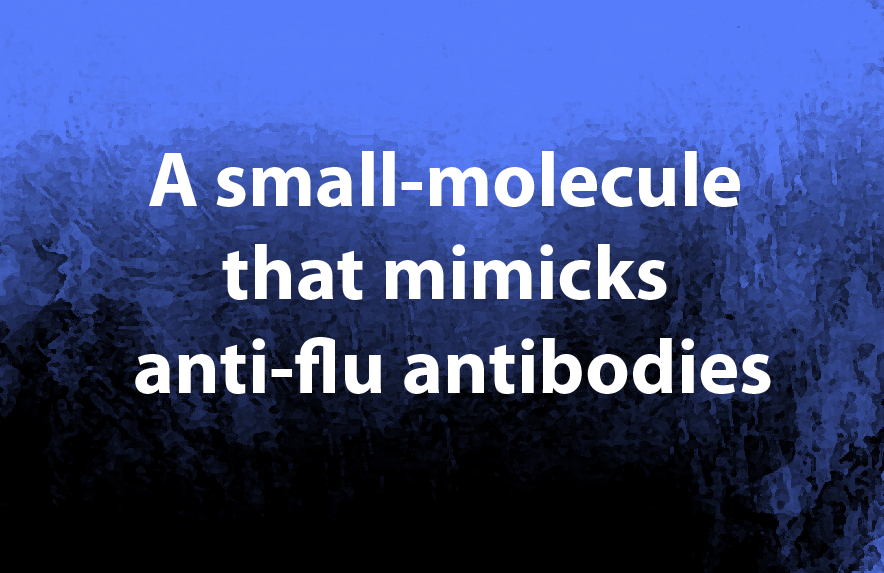A small-molecule that mimicks anti-flu antibodies
Flu is a serious health problem: what are we doing about it?
Flu makes millions of people ill and kills hundreds of thousands every year. At the moment, seasonal flu vaccines are the best available defence against influenza virus, but the approach has limitations. The current generation of flu vaccines targets a variable and rapidly evolving region of the virus (1), therefore, to produce a seasonal flu vaccine, scientists need to rely on mathematical models to predict which flu strains are likely to be circulating next year (2). Once the prediction is made, large-scale vaccine production can begin, and enough vaccine can be stockpiled, ready for flu-season. However, these mathematical models don’t always get it right and multiple strains often co-circulate. This means that seasonal flu vaccines can fail and even the vaccinated can catch the infection.
Isn’t there anything better?
There is now new hope for a broad-spectrum, universal vaccine against influenza, stemming from the discovery of human broadly neutralizing antibodies (bnAbs). These bnAbs target highly conserved (slowly evolving) epitopes in the hemagglutinin (HA) stem part of the virus . By binding to their epitope, bnAbs block a conformational change in HA needed for endosomal fusion, and thereby prevent virus infection of target cells in the respiratory tract. This means the bnAbs can protect against a wide range of influenza strains and wouldn’t need to be constantly updated to keep up with that season’s flu (3). Indeed, several bnAbs are currently being tested in clinical trials.
Can we harness this information?
Vaccines can be incredibly effective, but drugs have some important advantages: small-molecules can be taken orally, have a long shelf-life, and are relatively cheap to produce. So could we make a drug that does the same as bnAbs? This is exactly what van Dongen at al. set out to do; to develop a small-molecule drug that mimics the function of bnAbs, including the inhibition of viral entry. Below, we describe what they did and their exciting results.
Some background: bnAb-guided drug development
About a decade ago, several studies reported efforts to develop anti-influenza agents guided by the co-crystal structures of a bnAb in complexed with influenza HA. This led to the production of small protein and peptides that could bind to and inhibit the HA conformational change needed for virus fusion. However, these could not be delivered orally.
The next step: from protein and peptides to small-molecule ligands
Unlike proteins and peptides, small-molecule ligands (drugs) can be packaged for oral administration. To identify candidate drugs that could reproduce the anti-influenza mechanism of bnAbs, van Dongen at al. screened a library of 500,000 small-molecule compounds. From these, 300 were identified that reliably bind to the influenza HA, among which the most promising was JNJ7918, a benzylpiperazine with low micromolar inhibitory concentrations against H1N1 and H5N1 strains of influenza. The drug’s chemistry was further tweaked to optimize its pharmacokinetic profile (solubility and metabolic stability), ultimately producing JNJ4796.
An orally effective anti-influenza drug
The efficacy of JNJ4796 was then demonstrated in mice. The authors report that oral administration of JNJ4796 protected mice from 25-times the median lethal dose of H1N1 influenza. So far so good, but for JNJ4796 to have practical utility, it would need to protect the cells of the human respiratory tract. To test this, van Dongen at al. used reconstituted three-dimensional cell culture of human bronchial epithelial cells (HBECs) to represent the target tissue of the human airway. Indeed, incubation of an influenza-infected HBEC culture with the candidate drug was able to reduce the influenza titers.
Antibody-guided, small-molecule discovery
Through additional assays and crystallographic analyses, the authors demonstrated that JNJ4796 mimics the bnAb-HA interactions and inhibits the critical conformational change of HA that the virus needs to for cell entry. As well as developing a promising drug candidate, this manuscript also provides a proof-of-principle for antibody-guided, small-molecule discovery and the value of carefully considering target epitope binding activities and the details of inhibition mechanisms during drug development.
(1) Sautto et al., Towards a universal influenza vaccine: different approaches for one goal, Virol J , 2018
(2) Guo e al., Multi-scale modeling for the transmission of influenza and the evaluation of interventions toward it, Scientific Rep, 2015
(3) Corti et al., Tackling influenza with broadly neutralizing antibodies, Curr Opin Virol, 2017




